Share this @internewscast.com
Aging brings many valuable perks, such as greater wisdom, richer experiences, and more time with loved ones. Unfortunately, joint health isn’t one of them. As you get older, protecting your joints and maintaining a well-functioning body becomes increasingly important. A 2022 study examining the connection between aging and metabolism revealed that a slower metabolism not only increases the risk of weight gain but also elevates chronic disease risk, as muscle mass naturally declines with age.
The good news is that you don’t have to sacrifice fat-burning workouts to avoid putting too much strain on your joints. We chatted with Rachel MacPherson, CPT, a certified personal trainer and strength and conditioning specialist, who reveals her top seven low-impact exercises to help you burn fat, increase strength, and stay active without the risk of injury.
The following exercises are designed to target each muscle group in your entire body, boost your core stability, and elevate your heart rate while supporting joint health so you can stay lean, fit, and mobile for many years to come. Read on for the detailed how-tos, and when you’re finished, be sure to check out The Only 5-Minute Workout You Need to Jumpstart Your Day.
Brisk Walking

Walking is one of the most convenient and accessible low-impact exercises you can do, but you can’t expect to go out for a leisurely stroll and reap any real benefits. To make walking an effective low-impact exercise, step it up a notch by walking at a brisk pace, including hills in your walk, or wearing a weighted vest. Plus, research shows that walking can reduce your risk of chronic diseases, like cardiovascular disease, diabetes, and dementia.
How to Do It:
- Stand tall, with your shoulders back and chest proud.
- Start walking at a brisk pace, making sure you’re breathing a little heavier than usual.
- Add an incline by walking uphill or using a treadmill’s incline feature to target your glutes and legs more.
- Maintain a brisk pace for 30-60 minutes.
Recommended Sets and Reps:
- Aim for 30 to 60 minutes three to five times per week.
“Brisk walking will elevate your heart rate and make you breathe a bit heavier (you should still be able to talk), and uses large muscle groups, especially if you walk on an incline setting on a treadmill or a hill,” MacPherson explains. “When walking, keep your back straight and tall, shoulders back, slightly brace your core, and wear comfortable shoes.”
Swimming or Water-Based Group Exercise Classes
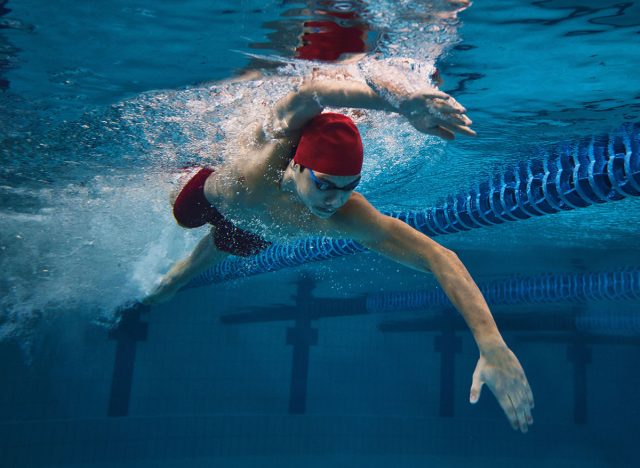
“Water-based activities are the ultimate low-impact form of physical activity,” MacPherson says. “Water keeps you buoyant, supporting your body weight, and as such, is naturally very gentle on your joints. Swimming is also a form of full-body cardiovascular exercise that helps burn fat and build strength. Also, group water-based classes like aerobics or resistance training use water as a form of resistance, sometimes with equipment like foam noodles or weights, so you’ll get even more out of your workout.”
How to Do It:
- For swimming laps, aim to swim continuously, alternating strokes for a full-body workout.
- For group water aerobics, follow the instructor’s lead for a full-body routine using the water’s resistance.
- Try using foam noodles or water weights to intensify the resistance.
Recommended Sets and Reps:
- Aim for 30 to 45 minutes, two to four times per week.
Elliptical Machine
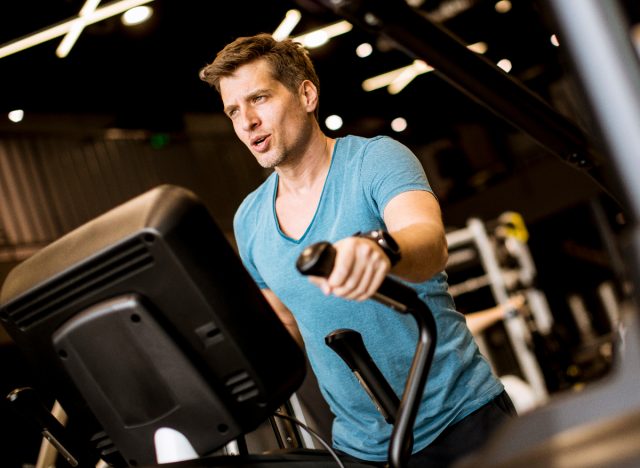
The elliptical machine mimics the movement of running or walking, but because your feet stay on the pedals, your joints stay protected. It also engages your upper body if you use the moving handles for a full-body workout.
How to Do It:
- Set the elliptical to a moderate resistance level.
- Start with your feet on the pedals and hands on the handles.
- Begin moving, maintaining a brisk pace while keeping your core engaged.
- Adjust the resistance to make the workout harder as needed.
Recommended Sets and Reps:
- Aim for 20-40 minutes, 3-4 times per week.
Wall Push-Ups
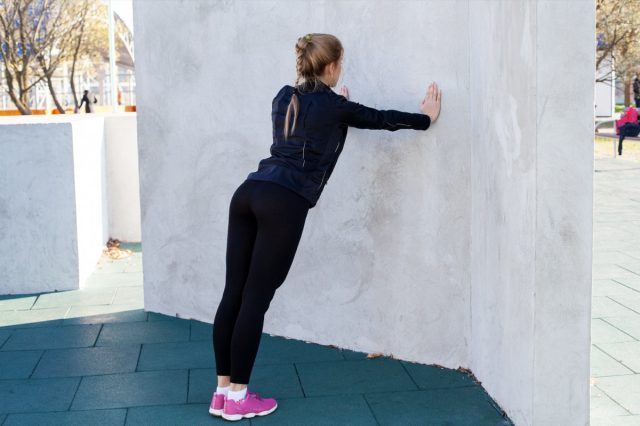
Push-ups are great for upper body strength, but traditional push-ups can be tough on the wrists and shoulders. Instead, try doing wall push-ups for a more joint-friendly alternative that targets the same muscles but with much less strain.
How to Do It:
- Stand facing a wall, about arm’s length away, with your palms flat on the wall at chest height.
- Keep your body straight from head to heels, and brace your core.
- Lower your chest toward the wall by bending your elbows.
- Push back up to the starting position.
Recommended Sets and Reps:
- Perform two to three sets of 10 to 15 reps.
“Resistance training is very effective for weight loss,” MacPherson says. “It boosts metabolism and helps maintain or even increase muscle mass during a weight loss diet. For a lower-impact version of standard push-ups that are more beginner-friendly, try wall push-ups. This version will put stress on your wrists and shoulders.”
Slow & Controlled Bodyweight Squats
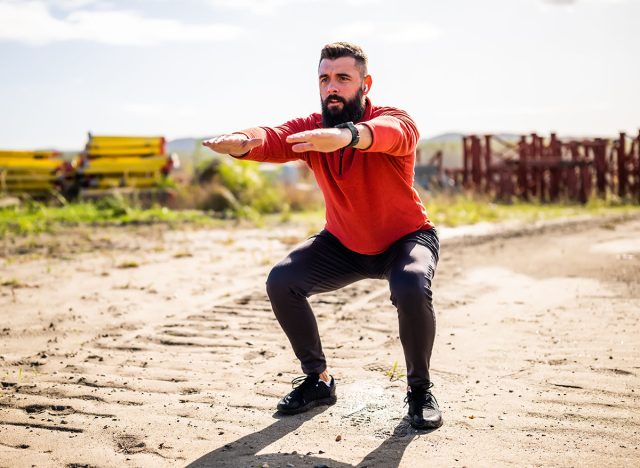
Studies suggest that squats are a fantastic exercise for building strength in your legs and glutes, but they can be tough on your knees if performed with bad form. When done with control and proper technique, bodyweight squats are a low-impact exercise that strengthens muscles while protecting the joints. MacPherson advises, “Use a slow and controlled motion to keep it low-impact and make the most of the exercise.”
How to Do It:
- Stand with your feet shoulder-width apart and chest lifted.
- Slowly lower your hips as if you’re sitting in a chair, making sure your knees track over your toes.
- Press through your heels to stand back up, keeping your chest tall.
- Move at a slow, controlled pace, taking about five seconds to lower and two seconds to rise.
Recommended Sets and Reps:
- Complete two to three sets of 10 to 15 reps.
Bird Dogs
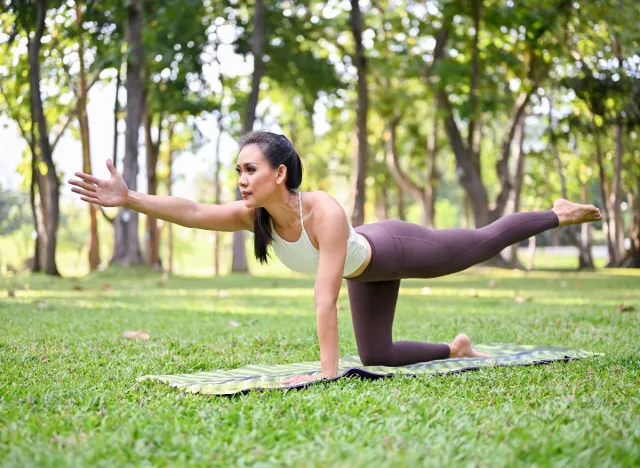
Bird dogs are an excellent move for improving core strength and stability without putting strain on your back or joints. However, MacPherson says you’ll need to rely on a lot of small muscles to keep yourself balanced.
“The key to making this challenging is to keep your core braced and your entire body active the whole time,” MacPherson explains. “You’ll be surprised at how your heart rate soars when concentrating on keeping yourself balanced and engaged through this movement.”
How to Do It:
- Start on all fours, with your hands directly under your shoulders and knees under your hips.
- Slowly extend your right arm forward while extending your left leg behind you.
- Hold for a count of two, then return to the starting position.
- Repeat on the opposite side.
Recommended Sets and Reps:
- Aim for two to three sets of 10 to 12 reps per side.
Resistance Band Rows
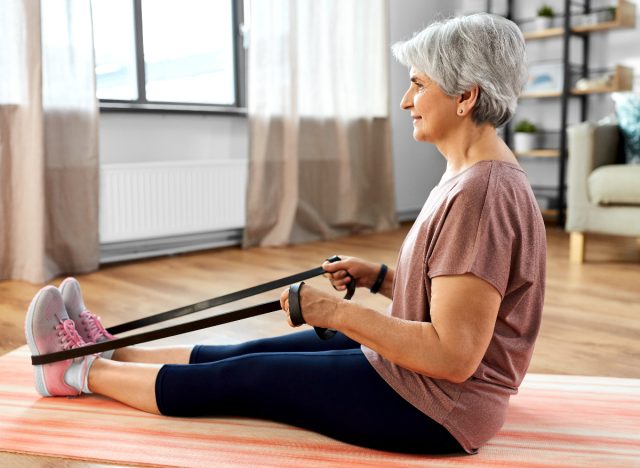
Free weights like dumbbells and barbells can be hard on your joints. Fortunately, that’s where resistance bands can be a strength training life savor. MacPherson says, “Rows target the mid and upper back and biceps muscles with help from the rear delts, building muscle and increasing your metabolism.”
How to Do It:
- Sit on the floor with your legs extended in front of you, or stand with your feet shoulder-width apart.
- Loop a resistance band around your feet or anchor it at chest height.
- Hold the band with both hands, keeping your back straight and chest lifted.
- Pull the band toward your body, squeezing your shoulder blades together, then slowly return to the starting position.
Recommended Sets and Reps:
- Perform two to three sets of 12 to 15 reps.
















